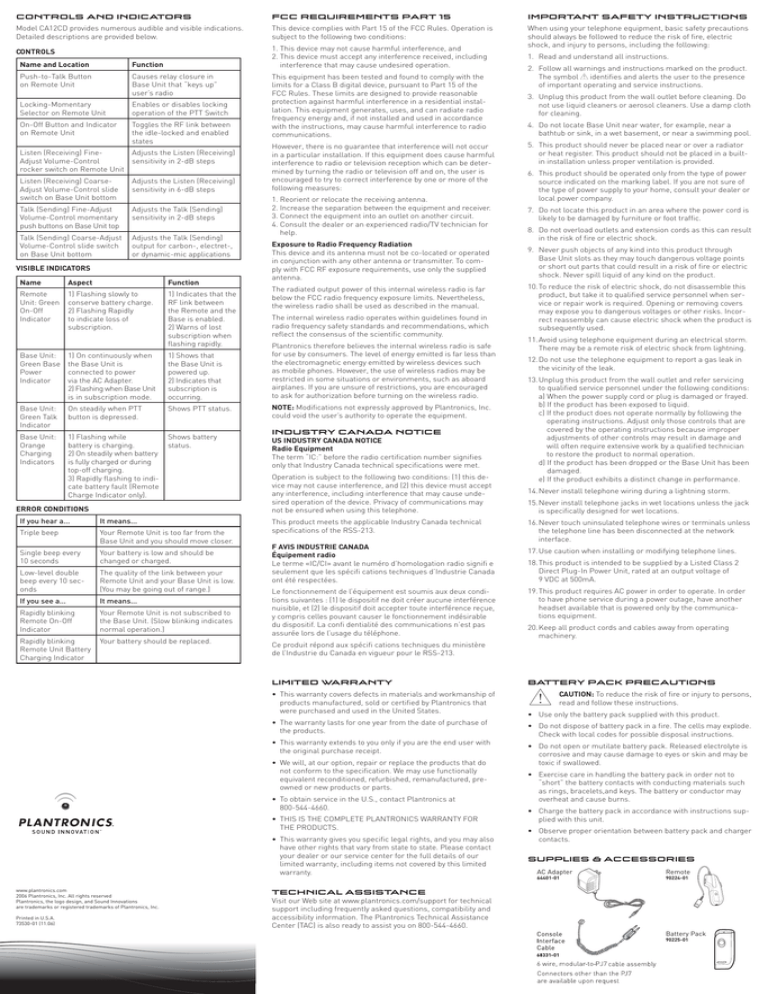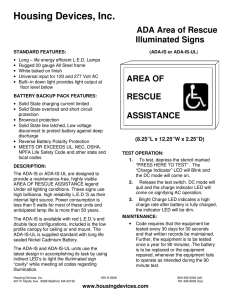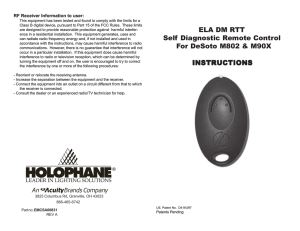
CONTROLS AND INDICATORS
FCC REQUIREMENTS PART 15
IMPORTANT SAFETY INSTRUCTIONS
Model CA12CD provides numerous audible and visible indications.
Detailed descriptions are provided below.
This device complies with Part 15 of the FCC Rules. Operation is
subject to the following two conditions:
CONTROLS
1. This device may not cause harmful interference, and
2. This device must accept any interference received, including
interference that may cause undesired operation.
When using your telephone equipment, basic safety precautions
should always be followed to reduce the risk of fire, electric
shock, and injury to persons, including the following:
Name and Location
Function
Push-to-Talk Button
on Remote Unit
Causes relay closure in
Base Unit that “keys up”
user’s radio
Locking-Momentary
Selector on Remote Unit
Enables or disables locking
operation of the PTT Switch
On-Off Button and Indicator
on Remote Unit
Toggles the RF link between
the idle-locked and enabled
states
Listen (Receiving) FineAdjusts the Listen (Receiving)
Adjust Volume-Control
sensitivity in 2-dB steps
rocker switch on Remote Unit
Listen (Receiving) CoarseAdjust Volume-Control slide
switch on Base Unit bottom
Adjusts the Listen (Receiving)
sensitivity in 6-dB steps
Talk (Sending) Fine-Adjust
Volume-Control momentary
push buttons on Base Unit top
Adjusts the Talk (Sending)
sensitivity in 2-dB steps
Talk (Sending) Coarse-Adjust
Volume-Control slide switch
on Base Unit bottom
Adjusts the Talk (Sending)
output for carbon-, electret-,
or dynamic-mic applications
VISIBLE INDICATORS
Name
Aspect
Function
Remote
Unit: Green
On-Off
Indicator
1) Flashing slowly to
conserve battery charge.
2) Flashing Rapidly
to indicate loss of
subscription.
1) Indicates that the
RF link between
the Remote and the
Base is enabled.
2) Warns of lost
subscription when
flashing rapidly.
Base Unit:
Green Base
Power
Indicator
1) On continuously when
the Base Unit is
connected to power
via the AC Adapter.
2) Flashing when Base Unit
is in subscription mode.
1) Shows that
the Base Unit is
powered up.
2) Indicates that
subscription is
occurring.
Base Unit:
Green Talk
Indicator
On steadily when PTT
button is depressed.
Shows PTT status.
Base Unit:
Orange
Charging
Indicators
1) Flashing while
battery is charging.
2) On steadily when battery
is fully charged or during
top-off charging.
3) Rapidly flashing to indicate battery fault (Remote
Charge Indicator only).
Shows battery
status.
ERROR CONDITIONS
If you hear a…
It means…
Triple beep
Your Remote Unit is too far from the
Base Unit and you should move closer.
Single beep every
10 seconds
Your battery is low and should be
changed or charged.
Low-level double
beep every 10 seconds
The quality of the link between your
Remote Unit and your Base Unit is low.
(You may be going out of range.)
If you see a…
It means…
Rapidly blinking
Remote On-Off
Indicator
Your Remote Unit is not subscribed to
the Base Unit. (Slow blinking indicates
normal operation.)
Rapidly blinking
Remote Unit Battery
Charging Indicator
Your battery should be replaced.
This equipment has been tested and found to comply with the
limits for a Class B digital device, pursuant to Part 15 of the
FCC Rules. These limits are designed to provide reasonable
protection against harmful interference in a residential installation. This equipment generates, uses, and can radiate radio
frequency energy and, if not installed and used in accordance
with the instructions, may cause harmful interference to radio
communications.
However, there is no guarantee that interference will not occur
in a particular installation. If this equipment does cause harmful
interference to radio or television reception which can be determined by turning the radio or television off and on, the user is
encouraged to try to correct interference by one or more of the
following measures:
1. Reorient or relocate the receiving antenna.
2. Increase the separation between the equipment and receiver.
3. Connect the equipment into an outlet on another circuit.
4. Consult the dealer or an experienced radio/TV technician for
help.
Exposure to Radio Frequency Radiation
This device and its antenna must not be co-located or operated
in conjunction with any other antenna or transmitter. To comply with FCC RF exposure requirements, use only the supplied
antenna.
The radiated output power of this internal wireless radio is far
below the FCC radio frequency exposure limits. Nevertheless,
the wireless radio shall be used as described in the manual.
The internal wireless radio operates within guidelines found in
radio frequency safety standards and recommendations, which
reflect the consensus of the scientific community.
Plantronics therefore believes the internal wireless radio is safe
for use by consumers. The level of energy emitted is far less than
the electromagnetic energy emitted by wireless devices such
as mobile phones. However, the use of wireless radios may be
restricted in some situations or environments, such as aboard
airplanes. If you are unsure of restrictions, you are encouraged
to ask for authorization before turning on the wireless radio.
NOTE: Modifications not expressly approved by Plantronics, Inc.
could void the user’s authority to operate the equipment.
INDUSTRY CANADA NOTICE
US INDUSTRY CANADA NOTICE
Radio Equipment
The term “IC:” before the radio certification number signifies
only that Industry Canada technical specifications were met.
Operation is subject to the following two conditions: (1) this device may not cause interference, and (2) this device must accept
any interference, including interference that may cause undesired operation of the device. Privacy of communications may
not be ensured when using this telephone.
This product meets the applicable Industry Canada technical
specifications of the RSS-213.
F AVIS INDUSTRIE CANADA
Équipement radio
Le terme «IC/CI» avant le numéro d’homologation radio signifi e
seulement que les spécifi cations techniques d’Industrie Canada
ont été respectées.
Le fonctionnement de l’équipement est soumis aux deux conditions suivantes : (1) le dispositif ne doit créer aucune interférence
nuisible, et (2) le dispositif doit accepter toute interférence reçue,
y compris celles pouvant causer le fonctionnement indésirable
du dispositif. La confi dentialité des communications n’est pas
assurée lors de l’usage du téléphone.
• This warranty covers defects in materials and workmanship of
products manufactured, sold or certified by Plantronics that
were purchased and used in the United States.
• The warranty lasts for one year from the date of purchase of
the products.
• This warranty extends to you only if you are the end user with
the original purchase receipt.
• We will, at our option, repair or replace the products that do
not conform to the specification. We may use functionally
equivalent reconditioned, refurbished, remanufactured, preowned or new products or parts.
• To obtain service in the U.S., contact Plantronics at
800-544-4660.
• THIS IS THE COMPLETE PLANTRONICS WARRANTY FOR
THE PRODUCTS.
• This warranty gives you specific legal rights, and you may also
have other rights that vary from state to state. Please contact
your dealer or our service center for the full details of our
limited warranty, including items not covered by this limited
warranty.
Printed in U.S.A.
73530-01 (11.06)
2. Follow all warnings and instructions marked on the product.
The symbol identifies and alerts the user to the presence
of important operating and service instructions.
3. Unplug this product from the wall outlet before cleaning. Do
not use liquid cleaners or aerosol cleaners. Use a damp cloth
for cleaning.
4. Do not locate Base Unit near water, for example, near a
bathtub or sink, in a wet basement, or near a swimming pool.
5. This product should never be placed near or over a radiator
or heat register. This product should not be placed in a builtin installation unless proper ventilation is provided.
6. This product should be operated only from the type of power
source indicated on the marking label. If you are not sure of
the type of power supply to your home, consult your dealer or
local power company.
7. Do not locate this product in an area where the power cord is
likely to be damaged by furniture or foot traffic.
8. Do not overload outlets and extension cords as this can result
in the risk of fire or electric shock.
9. Never push objects of any kind into this product through
Base Unit slots as they may touch dangerous voltage points
or short out parts that could result in a risk of fire or electric
shock. Never spill liquid of any kind on the product.
10.To reduce the risk of electric shock, do not disassemble this
product, but take it to qualified service personnel when service or repair work is required. Opening or removing covers
may expose you to dangerous voltages or other risks. Incorrect reassembly can cause electric shock when the product is
subsequently used.
11.Avoid using telephone equipment during an electrical storm.
There may be a remote risk of electric shock from lightning.
12.Do not use the telephone equipment to report a gas leak in
the vicinity of the leak.
13.Unplug this product from the wall outlet and refer servicing
to qualified service personnel under the following conditions:
a) When the power supply cord or plug is damaged or frayed.
b) If the product has been exposed to liquid.
c) If the product does not operate normally by following the
operating instructions. Adjust only those controls that are
covered by the operating instructions because improper
adjustments of other controls may result in damage and
will often require extensive work by a qualified technician
to restore the product to normal operation.
d) If the product has been dropped or the Base Unit has been
damaged.
e) If the product exhibits a distinct change in performance.
14.Never install telephone wiring during a lightning storm.
15.Never install telephone jacks in wet locations unless the jack
is specifically designed for wet locations.
16.Never touch uninsulated telephone wires or terminals unless
the telephone line has been disconnected at the network
interface.
17.Use caution when installing or modifying telephone lines.
18.This product is intended to be supplied by a Listed Class 2
Direct Plug-In Power Unit, rated at an output voltage of
9 VDC at 500mA.
19.This product requires AC power in order to operate. In order
to have phone service during a power outage, have another
headset available that is powered only by the communications equipment.
20.Keep all product cords and cables away from operating
machinery.
Ce produit répond aux spécifi cations techniques du ministère
de l’Industrie du Canada en vigueur pour le RSS-213.
LIMITED WARRANTY
www.plantronics.com
2006 Plantronics, Inc. All rights reserved
Plantronics, the logo design, and Sound Innovations
are trademarks or registered trademarks of Plantronics, Inc.
1. Read and understand all instructions.
BATTERY PACK PRECAUTIONS
CAUTION: To reduce the risk of fire or injury to persons,
read and follow these instructions.
• Use only the battery pack supplied with this product.
• Do not dispose of battery pack in a fire. The cells may explode.
Check with local codes for possible disposal instructions.
• Do not open or mutilate battery pack. Released electrolyte is
corrosive and may cause damage to eyes or skin and may be
toxic if swallowed.
• Exercise care in handling the battery pack in order not to
“short” the battery contacts with conducting materials such
as rings, bracelets,and keys. The battery or conductor may
overheat and cause burns.
• Charge the battery pack in accordance with instructions supplied with this unit.
• Observe proper orientation between battery pack and charger
contacts.
SUPPLIES & ACCESSORIES
AC Adapter
64401-01
Remote
90224-01
TECHNICAL ASSISTANCE
Visit our Web site at www.plantronics.com/support for technical
support including frequently asked questions, compatibility and
accessibility information. The Plantronics Technical Assistance
Center (TAC) is also ready to assist you on 800-544-4660.
Battery Pack
90225-01
COMPONENTS OF MODEL CA12CD
USER GUIDE
Model
Charging Well for
Spare Battery Pack
CA12CD
Remote
On-Off Button
and
Indicator
............................................................
Push-to-Talk Headset Amplifier
Push-toTalk
Button
Console
Interface Cable
AC Adapter
Charging Well for
Remote Unit
Listen
(Receiving)
Fine-Adjust
Volume Control
Remote Unit
Battery Charging
Indicator (Orange)
Selector for
Momentary-orLocking PTT
Function
SPARE
CHARGE
TALK
VOLUME
BASE
POWER
Quick Disconnect™ Battery
for Headset
Pack
REMOTE
CHARGE
Battery-Charging
Contacts
Note: When the Battery Pack is
installed or changed, the On-Off
Indicator will begin to flash as soon
as the unit is ready for use. This may
require up to 45 seconds while the
Remote Unit determines and selects
the most reliable radio channel.
TALK
1
Setup
Plug in Console
Interface Cable
here
BACK VIEW OF BASE UNIT
1.1, 1.2
2
Battery Charging
& Management
2.1 To attach the Battery Pack to the Remote Unit, simply slide
the Battery Pack onto the Remote Unit and snap it into place.
Do not force them together.
2.2 The Base Unit is equipped with two battery-charging wells.
The larger well allows charging of the battery while it is
attached to the Remote Unit. The smaller well allows
charging of a spare Battery Pack all by itself.
2.3 Insert the Remote Unit and the spare Battery Pack into their
respective charging wells. The Charging Indicators will flash
while the Battery Packs are charging.
2.4 When a Battery Pack is charged, its Charging Indicator will
stop blinking and glow steadily.
2.5 The On-Off Indicator on the Remote Unit will begin to flash
as soon as the unit is ready for use. This may require up to
45 seconds while the Remote Unit determines and selects
the most reliable radio channel.
3
Operation
3.1 Model CA12CD operates within the 1.92–1.93 MHz frequency
range. Operation of other devices within this frequency range
will reduce the user density of Model CA12CD.
3.2 To maximize user density, always turn the Remote Unit off
when not in use.
3.3 Press the On-Off Button located on top of the Remote Unit.
The green On-Off Indicator will begin to flash. If the battery
has just been installed, the Remote Unit will automatically
turn on and the On-Off Indicator will begin to flash within
45 seconds. (Reference Section 1.3)
3.4 Depressing the Push-To-Talk (PTT) Button on the Remote
Unit will generate the “key” signal to your console or radio.
While the PTT Button is depressed, the green Talk Indicator
on the Base Unit will illuminate.
3.5 The operation of the PTT Button can be adjusted with a
screwdriver to be either lockable or non-lockable as shown.
PTT Indicator
Talk (Sending)
(Green)
Coarse-Adjust
Volume Control
REMOTE
CHARGE
TALK
VOLUME
BASE
POWER
Spare
Battery Pack
Charging
Indicator
(Orange)
TALK
Note: The factory
settings provide a
carbon-microphone
output level. No
adjustment is
typically required.
Talk (Sending)
Fine-Adjust
Volume
Controls
Base Unit
Power Indicator
(Green)
REMOTE UNIT
Plug in
AC Adapter
here
SPARE
CHARGE
1.1 Plug the modular connector on the Console Interface Cable
into the modular jack on the back of the Base Unit. Plug the
other end into your console.
1.2 Plug the AC Adapter into the wall outlet, and plug the round
power connector into the back of the Base Unit. The Base
Power Indicator will illuminate.
1.3 Slide the Battery Pack onto the Remote Unit. When the
Battery Pack is installed or changed, the On-Off Indicator will
begin to flash slowly as soon as the unit is ready for use. This
may require up to 45 seconds while the Remote Unit determines and selects the most reliable radio channel.
1.4 Attach a headset to the Remote Unit.
Listen (Receiving)
Coarse-Adjust
Volume Control
BOTTOM VIEW
OF BASE UNIT
BASE UNIT
1.5 To reduce the possibility of RF interference, these minimum
separation distances should be maintained:
• 18 inches from other CA12CD systems
• 12 inches from CRT-type computer monitors
Note: Except for adjusting the Listen (Receiving) Volume on the
Remote Unit to the user’s preference, no other adjustments are
typically required. Please refer to Section 3 for adjustment
instructions.
2.6 A fully charged Battery Pack will last for up to eight hours.
2.7 To maximize the life of the Battery Pack, turn the Remote
Unit off and place it into the charging well when not in use.
Prior to being used, Battery Packs must be charged for at
least one hour or until the Charging Indicator changes from
blinking to continuously on.
Charging Well for
Spare Battery Pack
Charging Well for
Remote Unit
2.8 A completely depleted battery requires three hours to fully
charge.
Note: Swap battery packs at the end of each shift.
Note: Always release (disengage) the PTT Button before
swapping Battery Packs.
SPARE
CHARGE
BASE
POWER
TALK
VOLUME
REMOTE
CHARGE
TALK
1.3, 2.1,
2.3, 2.4
3.5
How to select
the lockable
or nonlockable
switch position
Lockable Position
Note that the selector
slot is aligned vertically.
The Push-to-Talk Button
can be depressed
momentarily or locked
in the ON position by
first depressing then
sliding the button until
it locks.
Nonlockable Position
Turn the selector
horizontally. The Pushto-Talk Button can be
depressed momentarily
when you wish to speak.
3.6 To get the best audio performance from your CA12CD,
please use the guidelines on the separate card, Setting
Model CA12CD Audio Levels. Properly-adjusted audio levels
are especially important for avoiding sidetone echo, as well
as for being able to hear your callers and be heard clearly
by them.
3.7 The Base Unit and the Remote Unit are paired with each other
at the factory in a process called subscription. If you replace
your Remote Unit, or if your Remote Unit loses its subscription (shown by a rapidly flashing On-Off Indicator), you can
perform the subscription process as follows:
• Hold both of the Talk (Sending) Fine-Adjust Volume
Controls on the top of the Base Unit down.
• The Base Power Indicator will begin blinking.
• Hold the Remote Unit’s Listen (Receiving) Fine-Adjust
Volume Control in either the up or down position.
• The Remote Unit’s On-Off Indicator will turn on steadily
(no flashing).
• The Remote Unit will subscribe (or re-subscribe) to the
Base Unit, after which the Base Power Indicator will return
to the steadily on state and the Remote Unit’s On-Off
Indicator will go out.
• Unplug the AC Adapter from the Base Unit and then
plug it back in.
• Press the Remote Unit’s On-Off Button to enable
the RF link and use the CA12CD.
TALK
VOLUME
E
ER
Talk (Sending)
Fine-Adjust
Volume Controls
Listen (Receiving)
Fine-Adjust
Volume Control




